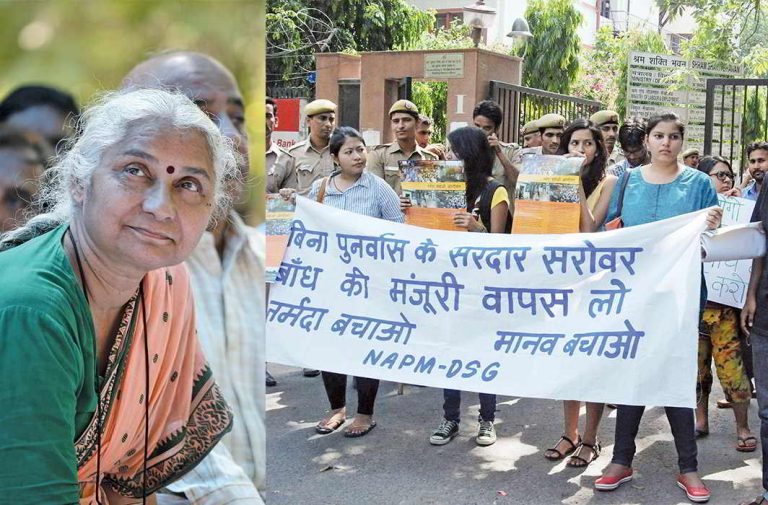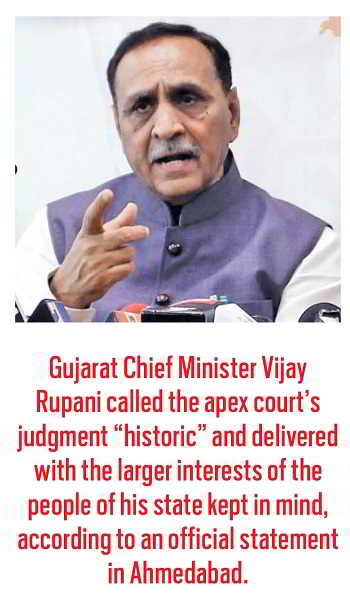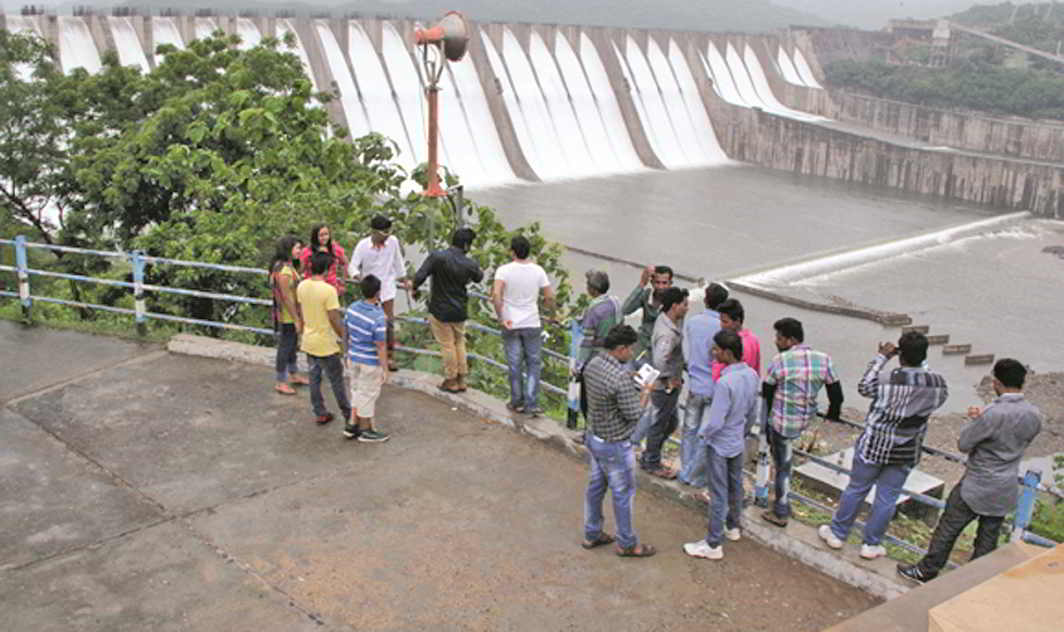
After 38 years, the Supreme Court directed a compensation of Rs 60 lakh each to be paid to 681 families hit by the Sardar Sarovar Project. In a rare gesture, both the Gujarat and Madhya Pradesh governments welcomed the order
By Rakesh Dixit
“You have been struggling for compensation for 38 years. We are going to give it to you in one shot,” Chief Justice of India Justice JS Khehar told Narmada Bachao Andolan (NBA) leader Medha Patkar on February 8. The remark accompanied the Supreme Court order hiking the compensation to the Sardar Sarovar Project (SSP) oustee families by more than 11 times—from Rs 5.5 lakh to Rs 60 lakh per family. Patkar, on whose petition the order came, was visibly satisfied.
Surprisingly, the two major respondents in the petition—the governments of Madhya Pradesh and Gujarat—too welcomed the court order. Seldom, if ever, in the 38-year-long legal dispute over the SSP, have both parties concurred with a court order.
Aimed at creating a better irrigation network and power generation, the project took off in 1979. However, it was marred by controversies after activists took to the streets and litigation resulted in inordinate delays and multi-fold cost escalation. The dam was finally completed in 2006, about two decades after construction began.
The SSP is one of India’s largest water resources projects, covering four major states—Maharashtra, Madhya Pradesh, Gujarat and Rajasthan. The dam’s spillway discharging capacity (30.7 lakh cusecs) would be the third highest in the world. With 40,000 cusecs capacity at the head regulator and 532 km in length, the Narmada main canal would be the largest irrigation canal in the world. The dam will be the third highest concrete dam (163 metres) in India, the first two being Bhakra (226 metres) in Himachal Pradesh and Lakhwar (192 metres) in Uttar Pradesh.
 The project site is situated across the Narmada river near Nandod district of Gujarat. The main dam, up to crest level of 121.92 metres, has been completed. Power potential of 1,450 MW has been created through a river bed powerhouse and a canal head powerhouse. Madhya Pradesh has 57 percent (826.50 MW) share and, accordingly, electricity is supplied to the state.
The project site is situated across the Narmada river near Nandod district of Gujarat. The main dam, up to crest level of 121.92 metres, has been completed. Power potential of 1,450 MW has been created through a river bed powerhouse and a canal head powerhouse. Madhya Pradesh has 57 percent (826.50 MW) share and, accordingly, electricity is supplied to the state.
The NBA claims the dam displaced 320,000 people—a majority of them poor tribal farmers who were not properly resettled on fertile land—and disrupted the lives of thousands more.
The official figure of the displaced families is 41,000 covering Gujarat, Madhya Pradesh and Maharashtra. Most families are from Madhya Pradesh. A three-judge bench headed by Justice Khehar and comprising Justices NV Ramana and DY Chandrachud, ordered payment of Rs 60 lakh to each of the 681 affected families in Madhya Pradesh who had not received any compensation for acquisition of their land.
The bench also ordered payment of Rs 15 lakh each to 1,358 families who had already received two instalments (these families had received cash compensation in lieu of land in two instalments—Rs 2.69 lakh in the first and around Rs 3 lakh in the second), saying: “They need to be further compensated so as to alleviate their hardship and enable them to purchase alternative land.” However, the order added, “amount already received by them shall be deducted from this money.”
These payments have to be made within two months on the condition that the affected families undertake to vacate their land for the project by July 31. The court said it was up to the state government to use force in order to get the land vacated if the families didn’t leave on their own by this date.
According to the bench, monetary compensation had been chosen as the proposed land compensation was not feasible. The court asked the Gujarat government to give the money to the Madhya Pradesh government’s Narmada Valley Development Authority (NVDA) for further distribution through its Grievance Redressal Authority headed by a retired High Court judge. The order is confined to Madhya Pradesh, as the highest number of oustees is from that state.
The bench clarified that all civil and criminal cases, including those emanating from the Jha Commission report on rehabilitation of families affected by the project, shall come to an end.
The Jha Commission, headed by a retired High Court judge, Justice SS Jha, was set up in 2008 by the Shivraj Singh Chouhan government on the Madhya Pradesh High Court’s order to look into allegations of irregularities in compensation to the project-affected families (PAFs). The commission, through a seven-year inquiry, found that government officials in collusion with middlemen had cheated the PAFs and got at least 1,589 fake sale deeds of land registered, causing a loss amounting to hundreds of crores of rupees to the government. The commission’s report was submitted to the Madhya Pradesh government last year but has not even been tabled in the assembly, much less acted upon. Instead of taking criminal action against the nexus, alleges Patkar, the Madhya Pradesh government is trying to propel the cash compensation scheme forward.
Taking cognisance of Patkar’s complaint, the court has directed the Grievance Redressal Authority to redress grievances related to resettlement sites where amenities are so lacking as to render them uninhabitable. This was reported by survey teams from IIT Mumbai and the Maulana Azad National Institute of Technology (MANIT), Bhopal after visiting the submergence areas. These reports are part of the Jha Commission Report.

Accusing the Madhya Pradesh government of shirking its duty to ensure the rehabilitation of PAFs, Patkar says the oustees, whose entitlement to land was not ensured, were either sent to Gujarat or were allotted absolutely uncultivable land for years. This was a clear violation of the Narmada Water Disputes Tribunal Award as well as the Supreme Court judgments.
Hailing this order, Patkar says it has demolished the false claims of the Madhya Pradesh government that everyone had been rehabilitated and nothing remained to be done. “I am happy with the order but I think the court should have covered more families for compensation as all the affected families would have benefitted then,” she said.
She also stated that the number of the affected who are yet to receive land and have not accepted cash payments is much higher than the government’s figure. “We will continue to present our case and will also fight to take the benefit as per the judgment for many others who deserve hike in compensation,” she added.
Patkar has challenged the Madhya Pradesh government to prove that the more than 40,000 families who are still in the submergence area have been rehabilitated, and all social-cultural monuments and amenities from the original villages have been shifted to the newly constructed houses at the rehabilitation sites. Until full rehabilitation is guaranteed, she says, she will not let the government forcefully evict people by July 31.
Meanwhile, the Gujarat government has hailed the ruling and assured that it will pay Rs 400 crore to Madhya Pradesh for disbursement at the earliest. Gujarat Chief Minister Vijay Rupani called the apex court’s judgment “historic” and delivered with the larger interests of the people of his state kept in mind, according to an official statement in Ahmedabad.
Deputy Chief Minister Nitin Patel added: “This judgment has paved the way to expedite the work on the dam. Once filled to the brim, this dam will provide water to lakhs of farmers and citizens of Gujarat.”
Narmada Valley Development Authority Chairman Rakesh Sahni, who represents Madhya Pradesh in SSP-related matters, says that, although he has yet to go though the fine print of the judgment, the state government is bound to honour it. “We will start implementation of the order as soon as the Gujarat government pays the compensation amount to the Madhya Pradesh government,” he said.
This rare concurrence over the court order among the affected parties suggests an end to the legal dispute on the compensation to the oustees. However, the Gujarat government’s decision in 2014 to raise the dam’s height is likely to prompt further judicial intervention in future. A panel of four retired judges— Justice VD Gyani (MP), Justice PC Jain (Rajasthan), Justice Nag Mohan Das (Karnataka) and Justice NK Mody (MP)—called the “Independent People’s Tribunal on SSP”, visited the affected area of the Narmada valley in September 2015. It alleged gross violation of the Narmada Water Disputes Tribunal Award and Supreme Court judgments.
The visit occurred in the backdrop of the controversy over the Narmada Control Authority (NCA) decision to allow the Gujarat government to raise the height of the Sardar Sarovar dam in that state from 121.92 metres to 138.62 metres by installing gates on it. The Madhya Pradesh High Court later stayed the operation of the order, which came less than a month after the Narendra Modi government’s ascension in May 2014.
The four-member panel said the NCA’s permission to increase the dam height might be legally untenable. The judges claimed sufficient evidence that rehabilitation and resettlement of people already affected by the 121.92-metre height was nowhere close to complete. At least 33 villages in Maharashtra and 193 villages and a town (Dharampuri) in MP were yet to be completely rehabilitated, they said.
Patkar corroborates this. “Over 192 villages and a township will come under submergence if the dam gates are closed. Of these, 126 villages are densely populated,” she says. So, though the NBA’s legal battle for compensation might have ended, the one for rehabilitation will soldier on.

